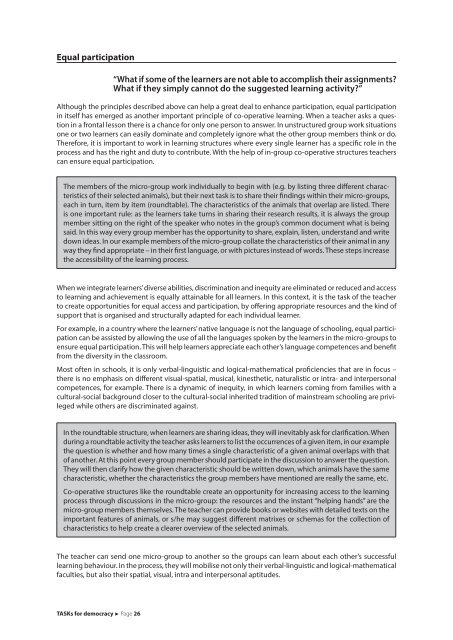TASKs for democracy
4NYw4W
4NYw4W
Create successful ePaper yourself
Turn your PDF publications into a flip-book with our unique Google optimized e-Paper software.
Equal participation<br />
“What if some of the learners are not able to accomplish their assignments?<br />
What if they simply cannot do the suggested learning activity?”<br />
Although the principles described above can help a great deal to enhance participation, equal participation<br />
in itself has emerged as another important principle of co-operative learning. When a teacher asks a question<br />
in a frontal lesson there is a chance <strong>for</strong> only one person to answer. In unstructured group work situations<br />
one or two learners can easily dominate and completely ignore what the other group members think or do.<br />
There<strong>for</strong>e, it is important to work in learning structures where every single learner has a specific role in the<br />
process and has the right and duty to contribute. With the help of in-group co-operative structures teachers<br />
can ensure equal participation.<br />
The members of the micro-group work individually to begin with (e.g. by listing three different characteristics<br />
of their selected animals), but their next task is to share their findings within their micro-groups,<br />
each in turn, item by item (roundtable). The characteristics of the animals that overlap are listed. There<br />
is one important rule: as the learners take turns in sharing their research results, it is always the group<br />
member sitting on the right of the speaker who notes in the group’s common document what is being<br />
said. In this way every group member has the opportunity to share, explain, listen, understand and write<br />
down ideas. In our example members of the micro-group collate the characteristics of their animal in any<br />
way they find appropriate – in their first language, or with pictures instead of words. These steps increase<br />
the accessibility of the learning process.<br />
When we integrate learners’ diverse abilities, discrimination and inequity are eliminated or reduced and access<br />
to learning and achievement is equally attainable <strong>for</strong> all learners. In this context, it is the task of the teacher<br />
to create opportunities <strong>for</strong> equal access and participation, by offering appropriate resources and the kind of<br />
support that is organised and structurally adapted <strong>for</strong> each individual learner.<br />
For example, in a country where the learners’ native language is not the language of schooling, equal participation<br />
can be assisted by allowing the use of all the languages spoken by the learners in the micro-groups to<br />
ensure equal participation. This will help learners appreciate each other’s language competences and benefit<br />
from the diversity in the classroom.<br />
Most often in schools, it is only verbal-linguistic and logical-mathematical proficiencies that are in focus –<br />
there is no emphasis on different visual-spatial, musical, kinesthetic, naturalistic or intra- and interpersonal<br />
competences, <strong>for</strong> example. There is a dynamic of inequity, in which learners coming from families with a<br />
cultural-social background closer to the cultural-social inherited tradition of mainstream schooling are privileged<br />
while others are discriminated against.<br />
In the roundtable structure, when learners are sharing ideas, they will inevitably ask <strong>for</strong> clarification. When<br />
during a roundtable activity the teacher asks learners to list the occurrences of a given item, in our example<br />
the question is whether and how many times a single characteristic of a given animal overlaps with that<br />
of another. At this point every group member should participate in the discussion to answer the question.<br />
They will then clarify how the given characteristic should be written down, which animals have the same<br />
characteristic, whether the characteristics the group members have mentioned are really the same, etc.<br />
Co-operative structures like the roundtable create an opportunity <strong>for</strong> increasing access to the learning<br />
process through discussions in the micro-group: the resources and the instant “helping hands” are the<br />
micro-group members themselves. The teacher can provide books or websites with detailed texts on the<br />
important features of animals, or s/he may suggest different matrixes or schemas <strong>for</strong> the collection of<br />
characteristics to help create a clearer overview of the selected animals.<br />
The teacher can send one micro-group to another so the groups can learn about each other’s successful<br />
learning behaviour. In the process, they will mobilise not only their verbal-linguistic and logical-mathematical<br />
faculties, but also their spatial, visual, intra and interpersonal aptitudes.<br />
<strong>TASKs</strong> <strong>for</strong> <strong>democracy</strong> Page 26


